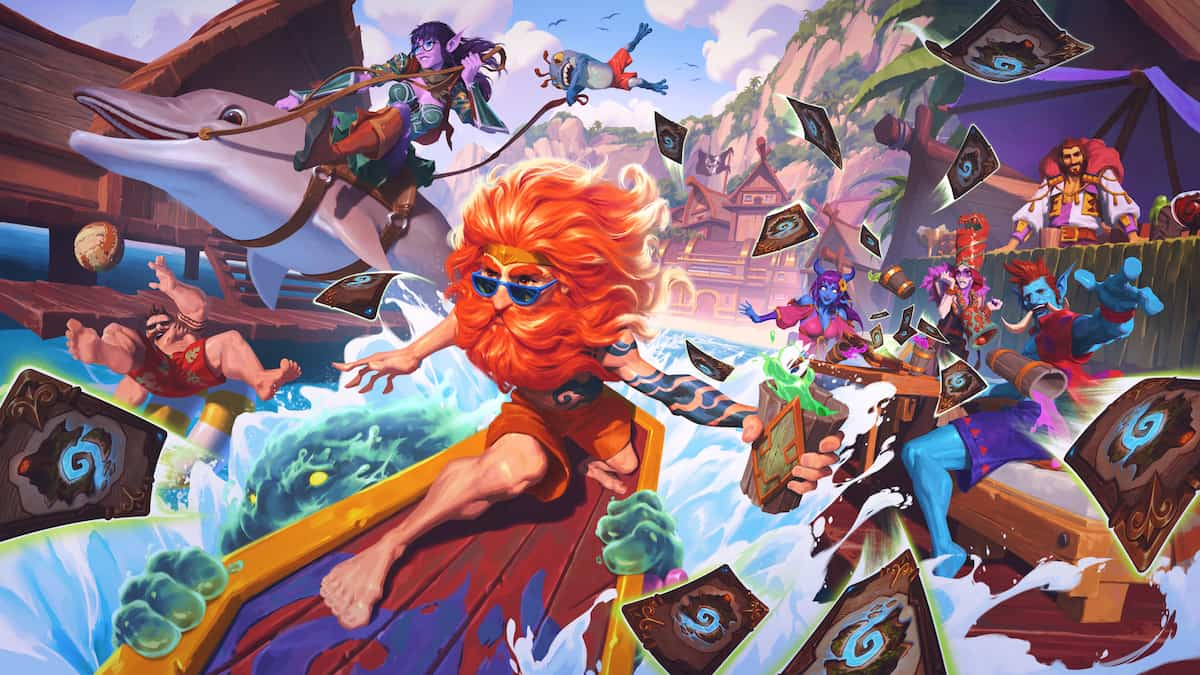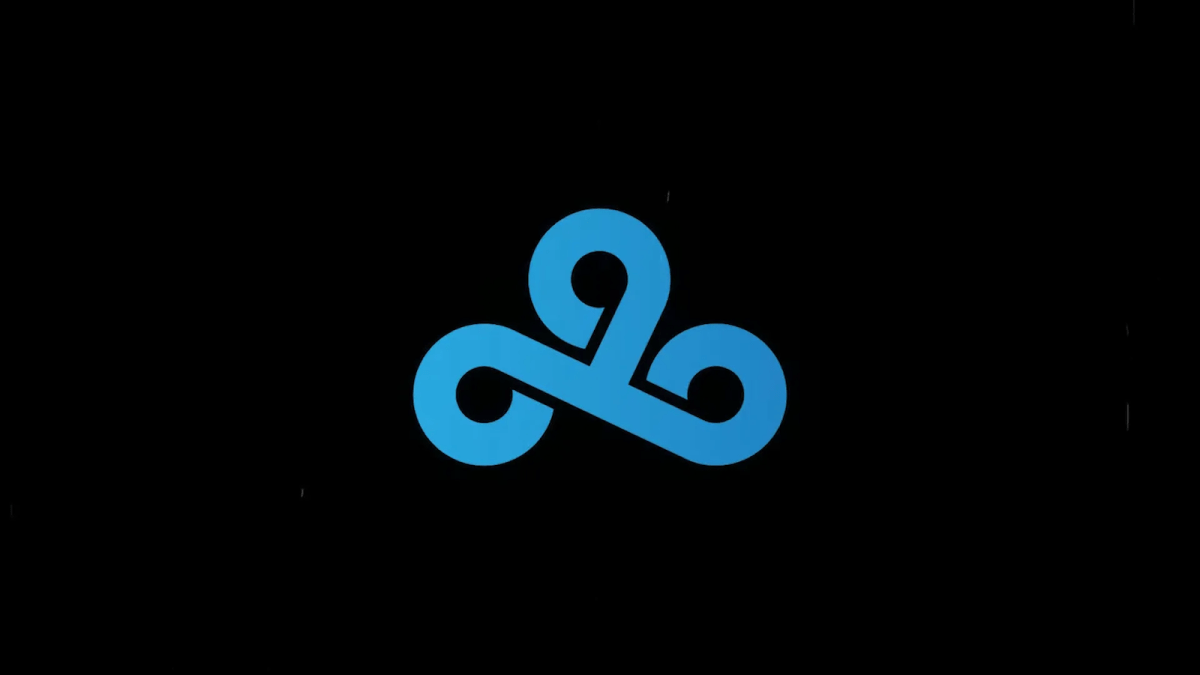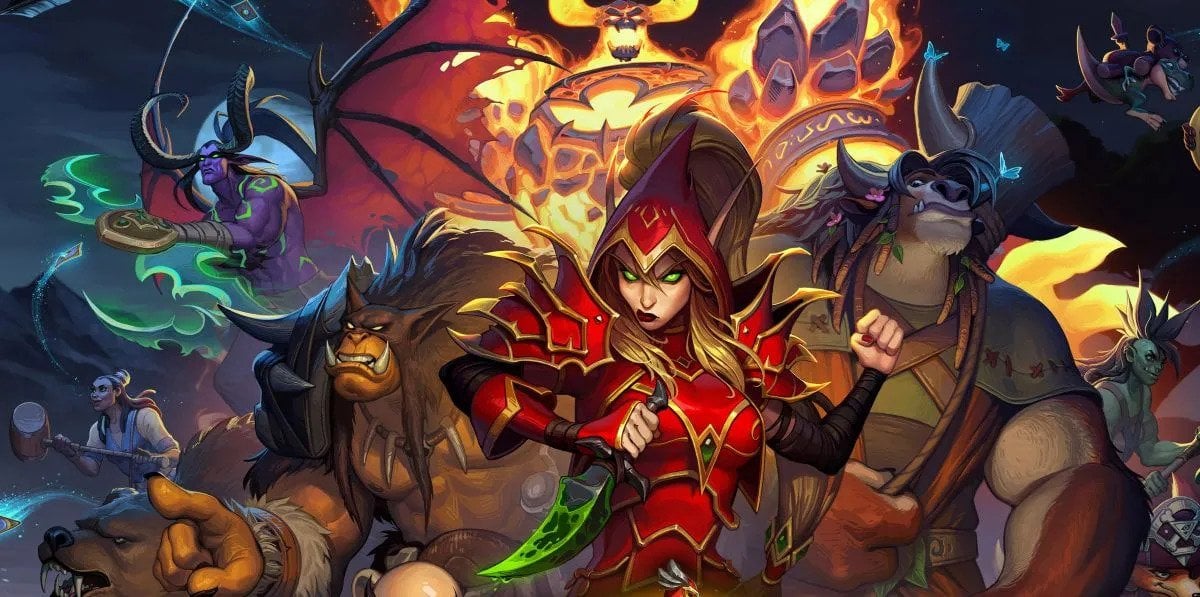April 2022 marked the release of Hearthstone’s 20th expansion in the form of Voyage to the Sunken City. That’s an extensive amount of cards and ideas packed into the past couple of years. Not all releases turned out the same, though, and while your mileage may vary, this list of all Hearthstone expansions should give you a good idea of the trajectory of the game and the ups and downs of what we’ve got to play with so far.
The League of Explorers
To this day, there’s still nothing quite like The League of Explorers in Hearthstone. A small and tightly crafted adventure experience with memorable characters that are still around to this day, on cards that all turned out to be relevant but not oppressive in Constructed, released less than a week after its announcement as a massive surprise to the community. It also gave us one of the most Hearthstone-y keyword in the form of Discover, which is now a staple in the game.
Journey to Un’goro
No one would blame you if you placed this set on top of your personal list. The card design department really knocked it out of the park with this one, even if Adapt was a fairly underwhelming keyword (and the one card that actually made use of it well, Vicious Fledgling, a permanent problem). Diverse archetypes across multiple classes, the introduction of Quests, and uniquely designed defensive and utility cards in the Neutral slots make this one of the best-designed sets in the game to date.
Knights of the Frozen Throne
You can’t really get much better than Hero cards when it comes to excitement and sheer “oh no” game-change experience. From Deathstalker Rexxar to Bloodreaver Gul’dan, they turned out to be the cornerstone of modern Hearthstone and a beloved, if tough-to-balance card type. Again, no one would fault you for putting this expansion on the top of the list—though the power levels may have been just a tiny bit too high.
Whispers of the Old Gods
The first set after the introduction of Standard and the regular set rotation, WotOG gave us a fresh start with new class identities and interesting cards around some of the most ominous and unknowable characters from WoW. To this day, it remains the favorite of many players.
Voyage to the Sunken City
Though the set is still pretty new, Voyage to the Sunken City feels like one of the better Hearthstone sets so far. Dredge and Colossal both turned out to be excellent keywords, the flavor and the art is absolutely on point, and all classes have at least some sort of viability—it is the sort of metagame where the community complains about a wide variety of decks instead of just one, which is usually a good sign.
Kobolds and Catacombs
Capping off a super-memorable year after Un’goro and KoFT, Kobolds and Catacombs had a lot to live up to. It certainly did so in the solo content departure with Dungeon Run. Generally, the last expansions of the year feature stronger cards because they spend comparatively less time in the metagame before rotating to Wild, and that was certainly the case here, veering into oppressive territory on multiple occasions. Recruit just wasn’t a very interesting keyword to play with or against, but it was insanely strong in the right circumstances with little opportunities to counter it from the other side of the board. Carnivorous Cube and expensive Deathrattle minions cheated out at a low mana cost formed the foundation of multiple archetypes across a wide variety of classes, with Warlocks being especially egregious about all this—no wonder they were targeted by a ton of nerfs soon after the set’s release.
Scholomance Academy
Though the theming was a little unmemorable, Scholomance Academy more than made up for it in the card design department. The Dual-class cards were memorable, effective, and flavorful. The multitude of nutty one-drop minions like Pen Flinger, Tour Guide, and Animated Broomstick added a lot of interesting decision points to the games. Though the power level was perhaps a bit too high again (I’m looking at you, Lightning Bloom and Devolving Missiles), this was an interesting set with great ideas that translated well to gameplay.
Saviors of Uldum
If we were to judge expansions by their trailer videos, this would definitely be the number one contender. Unfortunately, we’ve also got the cards and the keywords, and the metagame to consider. Zephrys the Great was very cool, but the League of Explorers members were wasted by becoming class-specific cards, with Sir Finley in particular languishing in tier 3 decks throughout his time in Standard. The set also gave us Puzzle Box of Yogg-Saron, which may be the best or worst part of it, depending on your preferences.
Curse of Naxxramas
Naxx out! The first post-Classic Hearthstone content release still remains endearing, especially its solo adventure portion, even if the cards themselves seem vastly overtuned today. Undertaker Hunter was one of the strongest decks of all time, powered by cards like Haunted Creeper and Mad Scientist. Meanwhile, Loatheb and Sludge Belcher became instant midrange staples until the end of their time in Standard, and there was just too much sticky Deathrattle stuff in a game with limited board clear options to consider this a clear winner.
Rise of Shadows
The start of a year-long storyline featuring popular characters from Hearthstone’s past, Rise of Shadows came at an exceptionally poor time for Hearthstone. The new Specialist esport format pretty much killed audience interest with the endless Control Warrior mirrors featuring Archivist Elysiana reloads. The set did provide interesting gameplay, but most of its cards were swiftly outclassed later down the line—and the endless random resource generation brought along by Lackeys would be an issue for quite a while to come.
The Boomsday Project
It’s mostly because of the lack of Constructed impact that people disapprove of this otherwise quite alright set, as the cards therein simply couldn’t supersede the existing Genn/Baku strategies in Standard. The Legendary spells and the Project cards were hit-and-miss, and though there were some standout cards like Zilliax or Dr. Boom, Mad Genius, the set just didn’t do enough with the long-awaited return of Mechs to warrant a higher spot on this list.
Murder at Castle Nathria
Not many would have thought that Blizzard would go for “Murder” in an expansion name, but here we go. The theming is fun, and the reveal season was one of the most entertaining ones out there, and a permanent new(-ish) card type was introduced in the form of Locations. Infuse is an interesting keyword and the team pulled out all stops to promote board-based gameplay the way United in Stormwind went ultra-hard for promoting combo archetypes. Enter a metagame where Questline Hunter is still a top deck, Warlocks can reliably dish out +6/+6 buffs as early as turn three, Druids still have infinite mana, other Hunter decks have unmatchable tempo courtesy of the Wildseed cards and Shamans play a spruced-up version of the Control Murloc Shaman deck from the previous expansion. With seven of the ten cards posting a sub-50% win rate, ideas like Demon Hunter’s Relic package completely falling flat and so much of the game revolving around cheating out stats at a super-early juncture, the gameplay experience is just not that fun overall. The set’s great ideas are let down by the game’s latter-day League of Legends-esque design philosophy where (reliably) players get to run rampant with overtuned new stuff after the release of a set before a round of balance changes brings them back to where they should have been in the first place.
Madness at the Darkmoon Faire
By this point, it was getting a bit tiresome to see Hearthstone’s insistence on mining its own previous successes. This time, the Old Gods were recycled with very little Constructed impact, bringing along a near-irrelevant keyword in the form of Corrupt. The set is a mish-mash of unsupported archetypes and the occasional underpowered card, and you can’t help but feel like there was much more they could have done with the Darkmoon Faire theming.
Ashes of Outland
Oh, look, a tenth class! Oh look, it’s brutally overpowered and it pretty much dominated the entire metagame throughout the expansion’s life cycle despite unprecedentedly fast and harsh nerfs—multiple rounds of it, in fact. The shockingly overtuned state of Demon Hunter on release makes this one of the lesser sets by itself.
Mean Streets of Gadgetzan
Patches the Pirate. Pirate decks. A stupidly strong Priest archetype. Jades. Kazakus. Though everyone could find something to like in MSoG, they inevitably found a lot more to dislike. Regardless of what your preferred playstyle is, there was a lot going against it at the time, be it super-aggressive Warriors and Shamans, ultra-grindy Priests and Mages with their Reno decks, endless stat-vomiting from Jades: you had it all. The high power level of the set also made older strategies completely obsolete, with few alternatives to the top meta decks.
Forged in the Barrens
An underwhelming content release all in all, with Mercenaries around the corner, eventually bringing an earth-shattering ‘meh’ as the community reaction to it. The keywords were unappealing and fairly weak, while most of the supported archetypes didn’t get off the ground. Oh, and there was that short period after release when we were all playing WatchPostStone instead of the actual game. That wasn’t any fun.
Fractured in Alterac Valley
A decent, if not particularly memorable set, Fractured in Alterac Valley featured a somewhat underwhelming reimagination of the Horde-versus-Alliance battles in WoW, a shockingly weak keyword in the form of Honorable Kill, and a gameplay environment that was still revolving around the United in Stormwind problem cards. The set was meant to promote slower gameplay strategies but never really fulfilled this stated design goal.
Descent of Dragons
Yet another set full of problematic cards that launched in a cripplingly unbalanced state, Descent of Dragons gave us Galakrond Shaman and then Galakrond Rogue to hate. There were many other problematic gameplay mechanics on display here as well: Control Priest’s ability to generate near-infinite amounts of stuff, a mana-cheating Paladin deck(?!) with Nozdormu the Timeless, Dragoncaster into Puzzle Box of Yogg-Saron on turn six with Mage, nasty aggression with Face Hunter and endless Dragons in Druid. The near-limitless Dragon discovery options (especially with Dragonqueen Alexstrasza) turned out to be a bit too strong for its own good, something that wasn’t alleviated by the Galakrond’s Awakening mini-set.
Blackrock Mountain
BRM was a decent set at the time but hasn’t aged well. The fact that the adventure revolving around Dragons only gave us unplayable Dragon cards for Constructed at the time was a major disappointment—and that about covers half of the release by itself. There’s Patron Warrior, however, the core memory of those who played at the time, a frustrating deck with an undeniably high skill cap (and floor), which ensured that this adventure was not going to be as forgettable as TGT would be soon thereafter.
The Witchwood
The Year of the Raven came after a massive sugar high as the devs tried to rein in the power levels introduced in the previous three sets. Though this seemed like a healthy approach, it significantly lowered player interest in the game and led to the release of sets that couldn’t really compete with the past year’s card releases. Though The Witchwood gave us the Rush keyword, not much else remains interesting or memorable about the set today—except, of course, Genn and Baku, cards that warped the game to such an extent that they’d have to retire to Wild a year earlier than planned.
United in Stormwind
Never have combo decks been as strong in Hearthstone as when United in Stormwind was released, and regardless of whether you love or hate the archetype, the near-complete lack of counterplay options to the Sidequest cards that were clearly overtuned on release led to a very frustrating gameplay experience for many in the player base. Many nerfs were needed to get these spells back in line, and they are going to be a design issue for the foreseeable future.
Goblins Versus Gnomes
It was the first big expansion of Hearthstone, and it was clear the devs still had a lot to learn about their own game. Both the RNG and the power level levers were cranked to the max here, which turned out to be a problem all the way until the eventual introduction of Standard. Piloted Shredder remained an auto-include all along the way, much like Dr. Boom, and this is just the aggressive Neutral cards: Paladin leaned on the Shielded Minibot + Muster for Battle crutch for years, for example. Meanwhile, Mech Mage was built around RNG swings, much like how a good roll on Crackle or Imp-losion could decide a game all by itself.
Rastakhan’s Rumble
We have a bone to pick with this set because it was clearly the time when Hearthstone’s tournament mode was supposed to launch, one of the last features announced under Ben Brode that was canned shortly before release. Beyond this, there’s also little else to love here: the solo content was yet another rehash of Dungeon Run, the cards were not powerful enough to make an impact, and the Overkill keyword was both irrelevant and boring to play with.
The Grand Tournament
Despite having the Inspire keyword, no set was less inspiring upon release than TGT. Most of the cards were underpowered even at the time or lacked the archetypal support to have an impact on the metagame. The reason it’s not on the very bottom of this list is that many of its cards actually turned out to be vital later down the line, even if most players don’t associate it with this dud of a release: Totem Golem, Thunder Bluff Valiant, Buccaneer, Alexstrasza’s Champion and a couple of aggro Neutral minions.
One Night in Karazhan
Not even the awesome disco theme could save this bastardization of the Karazhan raid. The solo content is by far the worst in Hearthstone’s history, insultingly easy to play through even on Heroic, built around the storyline where the most powerful and interesting wizard of the land disappears for the whole affair. As for the cards, they were either useless or overpowered: Barnes and Spirit Claws remained an issue for years while memorable duds like Purify, Nightbane Templar, Protect the King! and other immediately unplayable tools polluted this small set release.







Published: Aug 8, 2022 09:20 pm